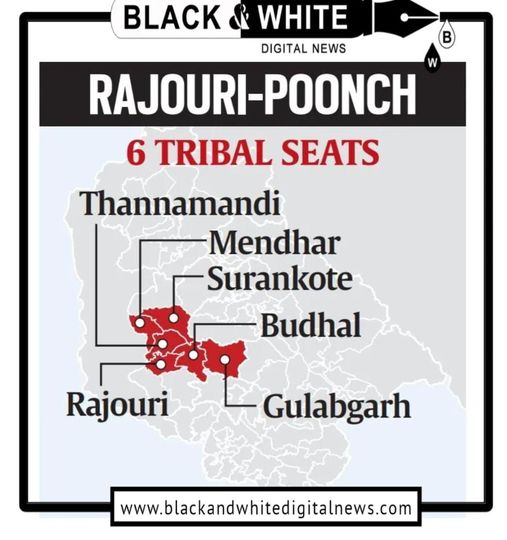Pahari-Gujjar Divide Heats Up Jammu’s First ST Electoral Battle: BJP and Opposition INDIA in Fierce Role Reversal.
||Black and White Digital News||
||Parvinder Singh 15,September ||
Jammu: The political landscape of Jammu and Kashmir (J&K) is witnessing an unprecedented shift as the Union Territory prepares for its first-ever Assembly elections featuring nine reserved Scheduled Tribe (ST) seats. What was once seen as a strategic advantage for the Bharatiya Janata Party (BJP) has now turned into a complex and divisive electoral battle, marked by a growing divide between Pahari Hindus and Gujjar-Bakarwal Muslims. The Opposition INDIA bloc, sensing an opportunity, is looking to exploit this rift, resulting in an intense political struggle over the six ST seats in Jammu’s Pir Panjal region.
The Aftermath of Article 370 and Delimitation:
The groundwork for this political contest was laid after the abrogation of Article 370 in August 2019, which stripped J&K of its special status. The following year saw the delimitation of constituencies, which reserved nine seats out of 90 for the STs—a first in the region’s electoral history. Of these, six are in the Jammu region, predominantly in the Rajouri-Poonch belt, and three are in Kashmir.
In February 2023, the BJP-led central government further reshaped the political equation by expanding the ST list, granting ST status to four new communities: Paharis, Paddaris, Gadda Brahmins, and Kolis. While the Gujjar and Bakarwal communities, both predominantly Muslim, were already included in the ST list, this new addition has complicated the political landscape. The Pahari community, though a mix of Muslims, Sikhs, and Hindus, is primarily dominated by Hindus, sparking concerns among Gujjars and Bakarwals about their political and social standing being diluted.
BJP’s Gamble with Paharis and Gujjars:
The BJP initially made significant inroads into the Gujjar-Bakarwal communities. In the 2014 Assembly elections, prominent Gujjar leader Abdul Ghani Kohli won the Kala Kote seat on a BJP ticket and later became a minister in the PDP-BJP coalition government. Another Gujjar candidate, Chowdhary Talib Hussain, narrowly lost the Rajouri seat by just 2,500 votes, showing the BJP’s potential to attract Gujjar voters.
However, the decision to include Paharis in the ST list has backfired in certain quarters. Several Gujjar-Bakarwal outfits have openly opposed the move and vowed to vote against the BJP. Despite this, the BJP has managed to secure the support of some prominent Gujjar leaders, hoping to balance Pahari and Gujjar votes in the crucial ST constituencies.
The Role Reversal: INDIA’s Play on Division:
As the BJP courts Pahari Hindus, the Opposition INDIA bloc, comprising the National Conference (NC) and Congress, is playing a different game. Recognizing the growing divide between Paharis and Gujjars-Bakarwals, the INDIA alliance is banking on religious polarization to gain an upper hand. With the BJP’s base shifting toward Pahari Hindus, INDIA is focusing on rallying the Gujjar-Bakarwal vote, seeking to split the Pahari vote by fielding Pahari Muslim candidates.
This electoral battle marks a significant role reversal in the region’s politics. In 2014, Jammu’s Hindu-majority areas overwhelmingly supported the BJP, while the Muslim-majority belts sided with the NC and the PDP. This time, the contest is far more complex, with ethnic and communal identities clashing across the region.
Rajouri: A Microcosm of the Divide:
The Rajouri seat exemplifies the broader dynamics at play. The BJP has fielded Vibodh Kumar Gupta, a Pahari Hindu, while the Congress has nominated Iftkar Ahmed, a Pahari Muslim. The PDP’s candidate, Tasadiq Hussain, is the only Gujjar in the race, which further complicates the contest. Although BJP rebel Chowdhary Talib Hussain, a prominent Gujjar leader, has withdrawn his nomination, the Congress is still hoping that religious polarization could tilt the balance in its favor. BJP insiders acknowledge that this division could undermine Gupta’s chances, despite his strong Pahari-Hindu base.
Gujjar-Bakarwal Consolidation: A Growing Challenge for BJP :
The first signs of a Gujjar-Bakarwal consolidation became apparent during the Lok Sabha elections when NC’s Mian Altaf Ahmed, a well-known Gujjar leader, won the Anantnag-Rajouri seat. The Gujjar-Bakarwal communities are thinly spread across the region, but their influence in the Rajouri-Poonch belt cannot be underestimated. With these communities now vocally opposing the Pahari inclusion in the ST list, the BJP’s path to victory is fraught with difficulties.
High Stakes Across Six ST Seats:
The six ST seats up for grabs—Rajouri, Budhal, Thannamandi, Surankote, Mendhar, and Gulabgarh—are critical for both the BJP and INDIA. In the last Assembly elections, the BJP failed to secure any of these seats, with the PDP, Congress, and NC sharing the spoils. With the delimitation creating the new Thannamandi seat and realigning constituencies, the electoral landscape has shifted further.
In the 2014 Assembly elections, the PDP emerged as the single largest party with 28 seats, compared to the BJP’s 25, NC’s 15, and Congress’s 12. The subsequent coalition government between the PDP and BJP fell apart in 2018, leaving J&K under central rule ever since. This time, the stakes are even higher as both INDIA and the BJP scramble for the ST seats that could prove pivotal in forming the next government.
The Road Ahead: Identity Politics and Electoral Strategy:
As J&K’s political landscape continues to evolve, the BJP’s gamble on Pahari support may either pay off or backfire spectacularly, depending on how the Gujjar-Bakarwal vote consolidates. The INDIA bloc’s strategy of banking on the Pahari-Gujjar divide introduces yet another layer of complexity to an already fragmented electorate. Both sides are navigating identity politics, balancing communal, regional, and ethnic factors as they battle for control of the six crucial ST seats.
With elections looming, the Pir Panjal region has become the epicenter of a high-stakes political contest that could reshape the future of J&K’s politics. The BJP’s challenge is to bridge the divide between its Pahari and Gujjar-Bakarwal voters, while INDIA focuses on deepening that rift to secure a crucial victory in the region’s first ST-reserved Assembly elections.



